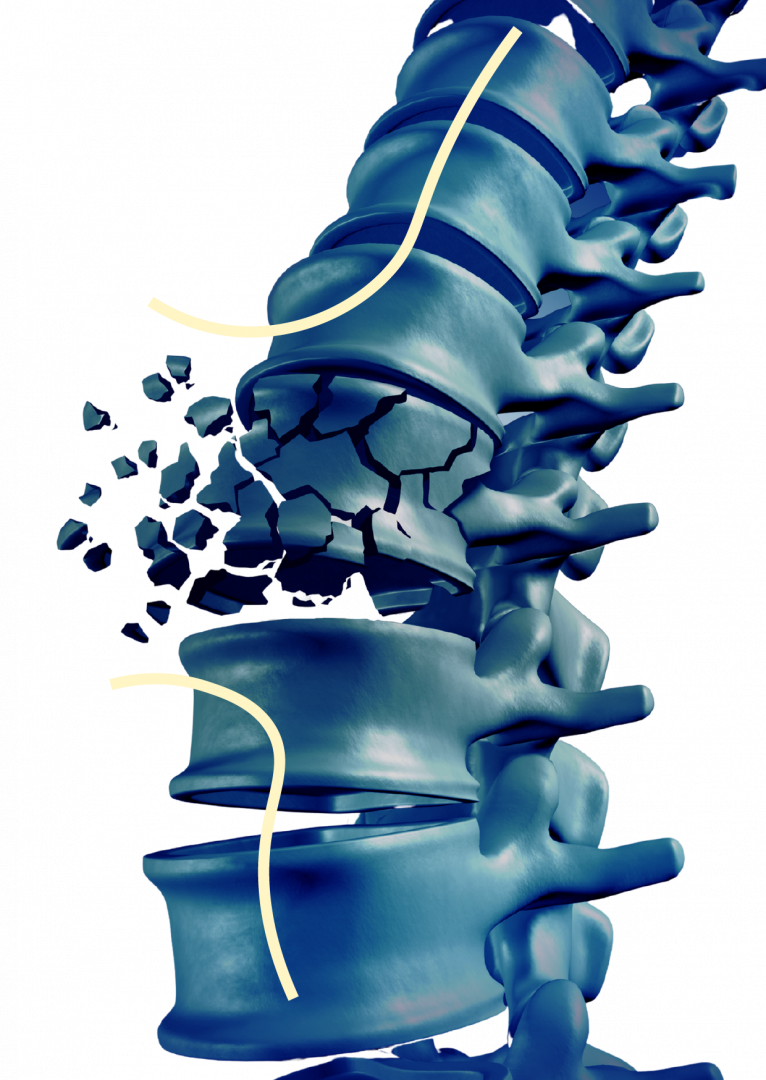Osteoporosis
Osteoporosis
Osteoporosis is a bone disease that causes a loss of bone density, which increases your risk of fractures. It is often referred to as a silent disease as patients do not feel changes in their bones or any pain. Osteoporosis occurs when the body loses too much bone or produces too little bone, or when both conditions occur. When a bone becomes brittle, a fall, even a sneeze or a slight collision can cause a bone fracture or fractures.
Osteoporosis does not cause pain; if back or hip pain becomes painful due to osteoporosis, it is because of bone fractures from the brittle bones causing severe pain, instability and deformity.
It is estimated that one-third of all women over 50 and one in five of all men over 50, will suffer an osteoporosis-related fracture at some point in their lives.
Causes of Osteoporosis
Under the microscope, healthy bones look like honeycombs. If osteoporosis occurs, the holes and spaces in the honeycomb will expand and the bone density will decrease. The bones become thinner and more porous and are more fragile, easily cracked, and broken.
Some factors that increase the risk of Osteoporosis include:
- Low body-mass index (BMI)
- Family history
- Smoking
- Excessive alcohol intake
- Sedentary lifestyle

Medical Conditions
Certain medical conditions put patients more at risk of bone loss, falls and fractures.
Rheumatoid Arthritis and Other Rheumatological Conditions
Mal-absorption Syndromes
Sex Hormone Deficiency (Hypogonadism)
Primary Hyperparathyroidism
Chronic Kidney Disease
Chronic Liver Disease
Diabetes
Secondary Osteoporosis
Drugs and diseases can cause bone loss, falls and/or fractures. Secondary Osteoporosis results from having another disease or condition or from the treatment of another condition.
- Steroid Medicines can increase the chance of bone loss and developing osteoporosis.
- Some breast cancer drugs, prostate cancer drugs, “heartburn” drugs have been associated with reduced bone mineral density.
- Excessive Thyroid Hormone Replacement in older adults has been associated with abnormal heart rhythms and muscle weakness, increasing the risk of falls and fractures. Excessive thyroid hormone replacement can also reduce bone mineral density and bone quality.
- Anti-seizure and Mood-altering Drugs have been associated with a reduction in bone density and this is believed to be due to low vitamin D and decreased intestinal absorption of calcium. Drugs that act on the central nervous system can cause falls by causing drowsiness, confusion, a drop in blood pressure, abnormal heart rhythms or a change in the normal functioning of the nerves and/or muscles of the body. Examples are some antidepressants, some types of sleep aids and some antipsychotic medications. The risk of falling increases as more of these medications are taken, particularly during the start or the sudden discontinuation of these drugs.
- Blood Pressure Medication: Some can increase the risk of falls and fractures in older adults. This occurs during the first few weeks of treatment because of a drop in blood pressure. Some of these drugs have also been associated with an increased risk of hip fracture when the drug is started. These drugs are important for reducing the risk of heart attack and stroke, but in order to prevent falls, caution should be taken when first starting them.
Symptoms
The risk of fracture increases if one has osteopenia or osteoporosis. The associated reduction in quality of life and mortality risk is significant and comparable to other major medical conditions such as cancers. It is important to look out for the following symptoms:
- Loss of height (getting shorter by 2cm or more).
- Change in posture (stooping or bending forward).
- Hip, spine, wrist fractures.
- Pain in the lower back.
Diagnosing Osteoporosis
Osteoporosis does not develop overnight. You can lose bone mass steadily for many years without experiencing any symptoms or signs of the disease until a bone Fractures. If osteoporosis is first diagnosed at the time a fracture occurs, it is already fairly advanced. Therefore, early detection of bone loss is critical in preventing osteoporotic fractures.
OSTA (Osteoporosis Self-assessment Tool for Asians) is a quick and easy test for Asian women that helps you discover your risk of osteoporosis.
Dual X-ray Absorptiometry DXA bone scan
If your risk is medium or high, it is important that you see your doctor for help as soon as possible. The medium-risk correlates to osteopenia. Osteopenia refers to early signs of bone loss that can turn into osteoporosis. Not everyone who has osteopenia develops osteoporosis.
Bone health is measured by bone density, which indicates the amount of minerals, such as calcium, in your bones. A higher bone density indicates stronger bones. To determine bone density, your health care provider will usually do a DXA bone scan. DXA scanning focuses on 3 main areas — the hip, spine and wrist.
Treatment Options for Osteoporosis
The goals of treatment are to provide pain relief, increase motion, and improve strength. There are several kinds of treatment:
Medication for Osteoporosis
Minimally Invasive Treatments for Osteoporosis
The medical cement will quickly coagulate and seal in the fracture, making the broken bones join. This process is minimally invasive without complications or downtime.
Surgery
Long term Management of Osteoporosis
After the patient is diagnosed with osteoporosis, she needs to undergo regular check-ups to understand the progress of her disease.
One can play an active role in self-management for the prevention of osteoporosis and falls.
- Calcium supplements aid optimal peak bone mass and the continuation of building new bone tissue as you age
- Vitamin D supplements help the body absorb calcium.
- Exercising regularly to keep the muscles of the back strong and flexible. Suitable weight-bearing exercises include walking, hiking, jogging, jumping, climbing steps, playing badminton, tennis and dancing
- Using the correct lifting and moving techniques to protect your back
- Preventing Falls
- Avoiding smoking and drinking
Get Your Pain Resolved
Send your enquiries or consult our pain experts today.


